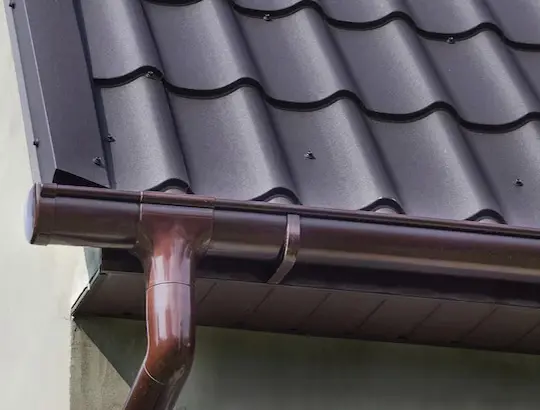Copper, Aluminum, Stainless Steel, Plastic: What These Different Materials Mean for Rain Gutters

Choosing gutter material is crucial as it directly impacts durability, aesthetics, maintenance, and overall performance. In this article, we will delve into the distinctive qualities of four popular rain gutter materials: Copper, Aluminum, Stainless Steel, and Plastic, to help you make an informed decision for your home’s protection.
1. Copper Gutters
Copper gutters are the epitome of elegance and charm, known for their timeless appeal and striking patina, which adds a touch of sophistication to any property and makes your home stand out with character. Aside from aesthetics, copper is incredibly durable and has a long lifespan, resisting corrosion even in harsh weather conditions. However, it comes at a higher initial cost than other materials. Still, many homeowners consider it a worthy long-term investment.
2. Aluminum Gutters
Aluminum gutters are a practical and budget-friendly option for rainwater management. They are lightweight, rust-resistant, and do not require painting, making them low-maintenance and perfect for various climates. Additionally, aluminum can be easily shaped into different profiles, giving homeowners flexibility in choosing a design that complements their home’s architecture. With proper installation and maintenance, aluminum gutters can protect your home from water damage while staying within a reasonable budget.
3. Stainless Steel Gutters
Stainless steel gutters are the epitome of strength and reliability. They boast exceptional resistance to rust, corrosion, and extreme weather conditions, ensuring they remain functional and attractive for decades. Stainless steel gutters offer a sleek and modern appearance that can complement contemporary home designs. Although they require a higher upfront investment, the minimal maintenance and long-term durability justify the cost for those seeking a top-tier rain gutter solution.
4. Plastic Gutters
Plastic or vinyl gutters are a lightweight and cost-effective option for rainwater management. They are easy to install, making them a popular choice for DIY enthusiasts. Plastic gutters come in various colors, allowing homeowners to match their home’s exterior. However, it’s essential to note that plastic gutters may not be as durable as metal options, and they can become brittle over time due to prolonged exposure to sunlight and extreme temperatures. As a result, they may require replacement more frequently.
Get Started
For any questions or concerns, get in touch with our knowledgeable staff today. We would be glad to assist you!
Contact Us TodayFactors to Consider When Choosing a Gutter Material :
Climate:Consider the weather conditions in your area. Harsh environments demand more robust materials like copper or stainless steel, while milder temperatures can do well with aluminum or plastic gutters.
Aesthetics: Your home’s architectural style and your personal preferences play a significant role in selecting the suitable material. Copper offers a classic, elegant look, while aluminum and stainless steel exude modernity.
Budget: Evaluate your budget and the long-term value of the gutter material. While copper and stainless steel require higher upfront costs, they can last much longer, potentially saving money in the long run.
As we conclude our exploration of rain gutter materials, we at Michaels Sheet Metal hope this article has provided you with valuable insights to make an informed decision. Each material offers unique advantages, be it the timeless charm of copper, the affordability of aluminum, the strength of stainless steel, or the practicality of plastic. Consider your budget, climate, and aesthetic preferences when choosing the ideal gutter material to safeguard your home for years to come. Don’t hesitate to consult professionals for expert advice and quality installation, ensuring your investment yields maximum protection and curb appeal.